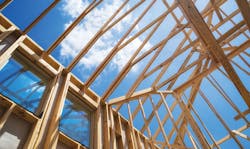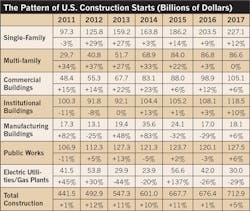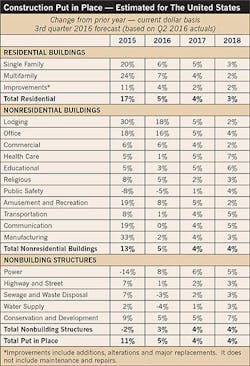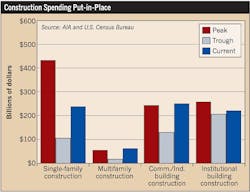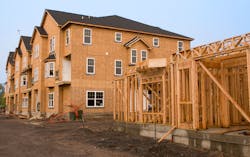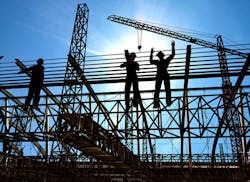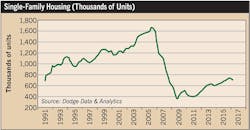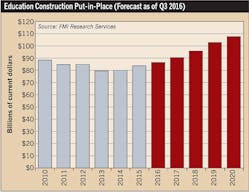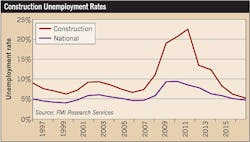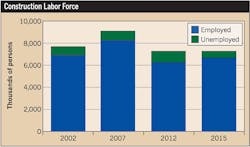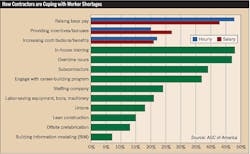After racing ahead for a few years, the U.S. construction market began to lose momentum in 2016. While it appeared the industry was slipping into a cyclical decline, economists now forecast that the industry still has room to grow.
“Total construction starts during the first half of this year lagged behind what was reported in 2015, raising some concern that the current construction expansion may have run its course,” says Robert Murray, chief economist for Dodge Data & Analytics. “Instead, the construction industry has now entered a more mature phase of its expansion.”
For example, in 2015, construction starts during the first half of the year were elevated by 13 projects valued at $1 billion or more. While 2016 did not get off to as strong a start, the year-to-date shortfall has grown smaller, Murray explains. In fact, he says 2016, in terms of the timing of very large projects, is a mirror image of what took place in 2015 — with more large projects reaching groundbreaking in this year’s second half.
“We saw a lot of volatility in the construction figures from 2014 through 2016, but it was related to the presence or absence of some very large projects in a given month,” Murray says. “As large projects began to reach the start stage in 2016, the year-to-date figures have become closer to what had been forecast earlier for the year as a whole.”
While 2017 will inevitably be characterized by slower rates of growth than during the 2012 to 2015 period, it is still growth. As such, Murray expects construction spending to experience moderate gains through 2017 and beyond. According to the “2017 Dodge Construction Outlook,” U.S. construction starts are expected to increase 5% to $713 billion in 2017, following an estimated 1% bump in 2016 and 11% gain in 2015 (Table 1).
Overall, Murray expects both non-residential and residential building to increase 8% and nonbuilding construction to dip 3%. Meanwhile, Kevin Haynes, senior consultant for FMI, forecasts the growth in the residential and nonresidential markets to hold steady at 4% to 5% (Table 2).
While multi-family, commercial, and industrial construction have nearly recovered from the downturn, institutional construction is still significantly below the last peak, and single-family construction has a long way to go until it reaches traditional trend levels (Fig. 1), says Dr. Kermit Baker, chief economist for the American Institute of Architects. See Six Trends in Key Markets on page 32 for highlights on how certain sectors are expected to perform next year.
Uncertain times
Alex Carrick, chief economist for ConstructConnect (formerly CMD), says the construction market is giving off mixed signals right now (Table 3).
“There are tremendous things going on with the economy, and the labor market is giving out very good signals,” Carrick says. “What is happening, however, is that construction isn’t really back to where it should be. There’s a lot of hesitation about embracing the better times.”
Traditionally, elections resolve a lot of uncertainty, but following this year’s presidential election, there were still many unknowns, Baker says. While he says it was still too early to determine exactly what measures would affect the construction outlook, he pinpointed several key areas worth watching for construction companies (see Key Areas to Watch Following the Presidential Election).
Two days after the election results were announced, Murray says he was still trying to assess what a Trump administration would mean for the construction industry.
“While public works is getting a lot of attention, how much funding will be available remains to be seen,” Murray says. “Other items, such as the repeal and replacement of Obamacare and tax reform, may be higher on the legislative list.”
As part of his “Make America Great Again” campaign, Trump also announced plans to dismantle the Dodd-Frank Act and replace it with other legislation. If this happens, it could contribute to more of a boom-bust pattern in the U.S. economy, which could potentially increase the severity of the downturn when it ultimately takes place, Murray says.
In FMI’s quarterly “Nonresidential Construction Index Survey,” 78% of the respondents reported that they don’t expect a recession until at least the first half of 2018, and 38% of these respondents don’t expect a recession for about two years.
Because the U.S. economy has stayed strong for longer than normal, Carrick says some analysts are foreseeing a slowdown in the future.
“We’ve had 88 months in a row of recovery or expansion, and that is a long period of time,” Carrick says. “Recoveries never usually last that long, and I’m wondering if the economy can stay on a roll. It has been moving along at about 2% growth this year, and the expansion and recovery phase is getting long in the tooth.”
On the upside, much of the news continues to be positive. Jobless claims in the United States have been less than 300,000 for 85 weeks in a row, which is unprecedented, Carrick says.
“There has been nothing like that since the very beginning of when the series was calculated in the 1970s,” Carrick says. “The unemployment rate is between 5% and 5.5%, and you rarely get that. The numbers are quite strong for construction.”
Following the election, Carrick says he expects some loosening of fiscal measures, more spending at the local and state level, and unemployment numbers to remain low. As such, he expects the U.S. economy to keep growing in the near term, even as the global economy still hasn’t achieved lift-off.
“Our economy is much stronger than it’s given credit for,” Carrick says. “The United States has, by far, the best economy in the world, and it’s growing at 1% to 1.5%. Meanwhile, Europe is still floundering, and while China’s economy may be growing faster, it’s coming off of a base that’s so much lower.”
Looking ahead, however, Brian Strawberry, a senior economist for FMI, is seeing fewer projects in the planning stages, especially in the private sector. As a result, uncertainty could creep back into the construction industry, Haynes says.
“What I’ve heard talking to contractors is an uneasiness is starting to go across the industry beginning in late 2018 into 2019,” Haynes says. “At that point, they start to get worried about what work is out there.”
Currently, Ken Simonson, chief economist for the Associated General Contractors of America, says he is seeing a disconnect between the available data and reports from contractors in the field. For example, he says construction spending and employment peaked in 2006, but then dropped steeply for five years before recently bouncing back (Fig. 2).
“We see ups and downs with no more upward trends, and from the data, construction appears to have had a six-month pause,” Simonson says. “Yet, we continue to hear from contractor members that they are very busy, their order books are still full, and no projects are being cancelled.”
Housing recovery
While economists expect the U.S. construction market to grow slowly in 2017, the housing market has not bounced back to where it should be, Carrick says.
“One of the real indicators of times returning closer to normal is if the housing starts were better,” Carrick says. “The forecast for single-family housing is that it will have an increase over the next several years, but that in 2020, it will not be as strong as before. Also, multi-family has come back, but it is not where it should be at this stage of expansion, which is casting an effect over all of the construction market.”
Next year, Murray forecasts a 12% increase in single-family housing for two reasons — older millennials are now becoming new homebuyers, and there’s an easing in lending standards (Fig. 3).
“Single-family had been the laggard of the housing recovery to date, but we are seeing it edge up from the steep downturn back in 2009,” Murray says.
Meanwhile, Murray says the multi-family sector experienced an exceptional level of activity in the New York metropolitan area due to foreign investment. While this market is now receding, other cities like Chicago and Atlanta are seeing an improved level of multi-family housing, he says.
“It’s still a relatively healthy market, even though we’re not seeing the growth that we have seen in recent years,”
Murray says.
Within the residential sector, multi-family continues to be more active than single-family, Haynes says. With that being said, however, he doesn’t expect it to be able to sustain the growth (Fig. 4).
“We had double-digit growth from 2012 to 2015, and we see a 7% growth this year,” Haynes says. “From 2017 to 2020, however, single-family is set to overtake multi-family. If you talk to contractors, however, you will find that they think the strength in multi-family will continue.”
Incline in institutional
An upturn in housing is followed by an increase in commercial and institutional building in a traditional construction cycle. As such, Murray says three sub-markets within the institutional category — education, amusement, and recreation — should experience a lift in 2017.
For example, Proposition 51 in California approved $9 billion for education-related projects, and other funding measures have been passed as well.
“With this support, the educational building market will certainly regain the upward trend that seemed to be established back in 2014,” Murray says.
A broader number of states passed a higher volume of bond issues since the recession, which fueled a pickup in K-12 construction, Simonson says. Some states, including New Mexico and Virginia, have cut funding for state universities, which could cause construction to remain weak in the public higher education sector, he says.
In a different vein, Strawberry is seeing an increase in higher education projects within FMI’s database.
“It’s one of the stronger markets,” Strawberry says. “I think as you build out the retail, commercial, and multi-family side of the market, you ultimately need the infrastructure, education, and health care to support the population in different markets.”
Haynes says the higher education projects are leading the way to a 5% growth in 2017 (Fig. 5). Specifically, he is seeing projects that bring more attention and funding to universities and colleges. For example, sports facilities, research and development centers, clean rooms, and labs are on the rise. In addition, he’s seeing companies add more dorms or complexes on or off college campuses to accommodate more students.
On the health care side, Haynes says some of the larger, more traditional hospital projects that have been delayed have started to pop back up. While there are not as many of them compared to five years ago, the shift has focused from large hospitals to health care clinics.
At the same time, however, Murray says that the outlook for health care, which includes hospitals, clinics, and nursing homes, may not be as bright for 2017 — especially considering the new presidential administration in the White House.
“The one institutional category that we don’t see contributing next year is health care facilities,” Murray says. “The probable repeal of Obamacare will create a dampening impact on health care related infrastructure in 2017.”
Impact of technology
In the commercial construction sector, technology could impact all of the major components — retail, offices, warehouses, and hotels — in 2017 and beyond, Carrick says. In today’s construction market, owners who are contemplating construction have options other than building square footage, Carrick says.
For example, shopkeepers now have the choice of building another brick-and-mortar location or investing in their platform on the Internet. This trend has also shifted to other sectors. With just a computer and Internet access, Americans can now work from home, stream a movie, do online banking, or book a stay at a guest house rather than a hotel.
“The whole world is changing so dramatically, and so many things are happening, which is changing the whole construction scene,” he says. “While there is still going to be construction, it’s impacting the square footage, the capital, and the dollar volume increases. Technology is changing everything.”
On the flip side, Haynes says many construction markets are positively impacted by the Internet and technology. For example, data centers and warehouses may actually see a surge in activity.
“Because there are more goods coming in, retailers need to find ways to store and transport them,” Haynes says. “This can positively affect some subsets of the commercial building market.”
Murray says warehouses have experienced steady increases in construction, decreases in vacancy rates, and a need for upgrades to handle new distribution technology (Fig. 6).
“The growth of online retail is creating a strong demand for warehouse projects,” says Murray, who forecasts a slight increase of 2% to 206 million square feet in 2017 for warehouses.
To meet consumers’ needs, more companies are building small distribution centers inside metropolitan areas, Simonson says. That way, a person can place an order online in the morning, and then pick up the product that same afternoon.
“There is now a pressure to build more of these, and, as a result, the size of the warehouse structures will be smaller,” Simonson says.
At the same time, technology has contributed to the subdued construction of retail, Murray says. He says stores — like single-family housing — had an unsustainable boom back in the mid-2000s, and they’re paying the price this decade (Fig. 7). After retail starts dropped sharply by 14% to 97 million square feet in 2016 (due in part to sluggish housing starts), Murray expects starts to rise 5% to 102 million square feet due to the growing economy, improved housing market, and recovery in consumer spending.
Within the retail sector, Simonson says he’s noticed a surprising amount of construction yet a huge number of store closings. For 2017, rather than more strip malls and big-box stores, Simonson expects new retail stores to be incorporated into multi-use developments, which can include lodging, multi-family housing, and office space.
In the office sector, Simonson is seeing a shift away from suburban office parks. Instead, he’s seeing two trends emerge — employees are working remotely in their homes or co-working spaces, and companies are creating office space in downtown areas by clearing lots and repurposing historic buildings.
“The nature of office construction is continuing to evolve to more city-based and dense projects,” Simonson says. “These tend to be expensive, so they will push up the value in place while reducing the square footage per employee.”
On the manufacturing front, Simonson says many large projects are now wrapping up. And, due to the strength of the U.S. dollar and trade policies under the new administration, more plants could move back into the United States.
Energy and infrastructure trends
While he expects many of the nonresidential market segments to be flat or negative, Simonson is forecasting moderate growth for two markets — power and highways/streets. Recently, several different factors have impacted the power industry, including a downturn in coal power plant construction and a significant drop off in drilling, Simonson says. On the bright side, however, the industry experienced a pickup in natural gas-fired power plants, the progression of pipeline projects, and the extension of renewable energy credits through the end of the decade.
“The power category will finish the year positively and grow from current levels next year,” Simonson says.
While the power market has been down due to a pullback in the oil and gas industry, several factors will lead to growth including the need for natural gas pipelines, the modernization of the grid, and more transmission and distribution lines, Strawberry says. Due to these factors, FMI expects a 6% growth for the power market in 2017, which will land it in the top five markets for growth rates.
One factor, however, is dragging down the entire electric power and gas plant category, Murray says. Liquefied natural gas (LNG) export terminal starts have plunged from $26 billion in 2015 to $10 billion for 2016 — with a proposed level of $6 billion for 2017.
“The Federal Energy Regulatory Commission approved a number of LNG plans to reach the start stage, but since then, there have not been the same number of terminals that have been approved,” he says.
Within the highway and street building sector, FMI expects a slight uptick in construction of 2% from 2017 through 2020. Going forward, Randy Giggard, managing director of research services for FMI, says states and communities will likely be responsible for finding funding for many of their highway and bridge projects — despite the passage of the Fixing America’s Surface Transportation (FAST) Act.
While the FAST Act is investing federal money into state highway programs, rail, and transit, it was a short-term extension rather than a permanent increase in transportation funding, and it was driven by tax increases, Simonson says. For that reason, he says states are uncertain about the availability of highway reauthorization and reimbursement through 2020.
Facing a labor shortage
As electrical engineering firms and electrical contractors move into 2017, they are likely to contend not only with heightened and dampened levels of activity in certain markets, but also a continued labor shortage. During the recession, waves of skilled workers left the construction industry to work in other market segments, and many of them never returned, driving up unemployment levels in the construction industry (Fig. 8).
“Prior to the downturn, companies were cutting their workforce by a third to a half, and now that we are coming out of the slump, there are no bodies to be found,” Haynes says. “We are finding a significant shortage of labor as individuals continue to get older, and contractors are losing people to other industries.”
Baker agreed that the labor shortage remains a concern. As the industry nears recovery, he says this issue will get worse before it gets better (Fig. 9).
“The number of employed construction workers is 1.8 million fewer than 2007,” Baker says. “Because the unemployment rate is under 5%, it’s difficult to find new workers, and it’s not favorable to long-term growth.”
Over the years, the employment situation has been a major concern for all contractors, Simonson says. According to a recent survey, he says contractors of all types are having difficulty filling a wide variety of positions, and they’re dealing with this issue in various ways (Fig. 10).
“Contractors are spending a lot more to find and train workers than they ever have before, and the pool of entry-level workers is shallower than it used to be,” Simonson says.
By paying higher entry-level wages and focusing on training, however, firms are boosting their staffing levels and focusing on the opportunities ahead in 2017. While they may not experience a surge in activity in certain markets, they should face slow and steady levels of construction, Haynes says.
“It will be a big change from the type of work standpoint,” Haynes says. “I think the electrical construction market will grow in 2017, but not as much as in previous years.”
Fischbach is a freelance writer and editor based in Overland Park, Kan. She can be reached at [email protected].
SIDEBAR 1: Key Areas to Watch Following the Presidential Election
In 2017, the outcome of the presidential election could impact the construction industry in several ways. Dr. Kermit Baker, chief economist for the American Institute of Architects, shares six predictions on how the new administration could affect the industry.
1. Trade policy could affect the price of building materials and products, with higher prices for imported materials and less competition for domestic products.
2. Immigration policy changes will directly impact labor force issues as construction companies struggle to find workers in the field and supervisors in the office.
3. Tax reform could lead to the possible lowering of corporate tax rates, which could lead to more investment in the economy.
4. Infrastructure is a high priority for the administration, which should boost the construction industry, yet exacerbate the labor problem. Also the current proposal is seeking private funding for infrastructure, which could work for some areas, but not in others.
5. Regulation could be reduced, which could lower the construction costs and speed up the construction process.
6. Finance most likely will be focused on with a rollback in Dodd-Frank provisions and reform of secondary mortgage markets.
Source: ConstructConnect Webinar titled, “Post Election Outlook for Design and Construction”
SIDEBAR 2: Six Trends in Key Markets
As electrical contracting companies and electrical engineering firms look ahead to market conditions in 2017, here are some of the major trends shaping predictions for next year.
Good news on the home front. In 2017, mortgage rates are likely to experience a moderate increase, but home prices will also continue to advance, says Robert Murray, chief economist for Dodge Data & Analytics. As a result, demand will outpace supply, leading single-family housing to continue on its uneven but upward trend, he says.
Slide in multi-family. For many years, multi-family projects surged ahead of single-family, but the roles have reversed, Murray says. In 2017, multi-family is expected to slip back 2% to 435,000 units. The spike in this sector can be attributed to the unusually high level of activity in New York, which has since subsided.
Bump in commercial construction. Overall, commercial work is expected to increase 4% to 648 million square feet and 6% to $105.1 billion. When looking at this sector, however, Murray says the individual components are performing disparately, and the starts have been on a roller coaster ride over the past decade. For 2017, companies should expect a moderate growth for offices, stores, and warehouses, and a slight pullback in hotel construction starts.
Institutional strengthening. For the institutional building market, Murray says 61% of the dollar value of starts came from government sources from 2000 through 2015. Since fiscal conditions at the local and state levels have improved, the recovery in this sector is finally taking hold. As a result, the starts should grow by 8% to 315 million square feet and 10% to $118.5 billion. The education, amusement, and transportation sectors should drive the upturn in this sector, while health care construction could face an uncertain future due to the election.
Swing in non-building starts. Like other categories within the construction market, this division includes segments that are performing at uneven levels. For example, the electric utility market is forecasted to retreat another 29% in 2017 after falling 26% in 2016 due to fewer LNG plant construction starts. Meanwhile, manufacturing building and public works are expected to register a 6% bump in 2017. “We’re forecasting a healthy level of power plant construction for 2017,” Murray says.
Increased funding for highways and bridges. While Murray says the passage of the FAST Act was a “major positive” for highway and bridge construction, he says it could take some time for the benefits of the transportation bill to show up at the construction site. For next year, however, he is forecasting a 5% increase to $62 billion in the highway and bridge sector.
Source: Dodge Construction Outlook 2017


